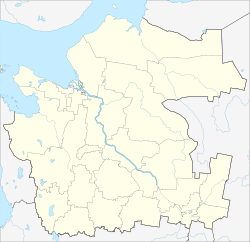112 헤르쿨리스
112 Herculis| 관측 데이터 에포크J2000이쿼녹스J2000 | |
|---|---|
| 별자리 | 헤라클레스 |
| 적경 | 18h 52m 16.428s[2] |
| 적위 | +21° 25' 30.51°[2] |
| 겉보기 등급(V) | 5.43[3] |
| 특성. | |
| 스펙트럼형 | B9p Hg[4](B6).5V + A2V)[5] |
| B-V 색지수 | −0.068±0.008[3] |
| 변수형 | 없음[6] |
| 측성학 | |
| 반지름 속도(Rv) | -19.8±0.9km[7]/s |
| 고유운동(μ) | RA: -7.526 mas/년[2] Dec.: -10.231 mas/년[2] |
| 시차(ppm) | 7.8558 ± 0.0728 mas[2] |
| 거리 | 415 ± 4 리 (127 ± 1개) |
| 절대 등급(MV) | −0.04[3] |
| 궤도[8] | |
| 기간( P) | 6.36246±0.00002 d |
| 편심률(e) | 0.11±0.03 |
| 근일점 시대(T) | 2,452,540.11±0.03 JD |
| 근일점의 인수 (1987) (보조) | 198±2° |
| 반진폭(K1) (기본) | 17.0±0.6km/s |
| 반진폭(K2) (보조) | 35±2km/s |
| 세부 사항 | |
| 기본적인 | |
| 덩어리 | ~5.0[5] M☉ |
| 반지름 | 2.888[9] R☉ |
| 광도 | 203+4 −3[9] L☉ |
| 표면 중력(log g) | 4.1[10] cgs |
| 온도 | 12,853±89[9] K |
| 회전 | 12.419 d[9] |
| 회전 속도(vsini) | 20km[11]/s |
| 이차적인 | |
| 덩어리 | ~2.5[5] M☉ |
| 표면 중력(log g) | 4.2[10] cgs |
| 기타 명칭 | |
| 데이터베이스 참조 | |
| SIMBAD | 데이터. |
허큘리스자리 112는 허큘리스자리에 있는 쌍성계입니다.겉보기 등급은 5.[3]43으로 맨눈으로 희미하게 볼 수 있습니다.두 번째 구성 요소는 [5]주성보다 약 2배 어둡습니다.시차 [2]측정에 따르면 이 계까지의 거리는 약 415광년입니다.-20 km/[7]s의 반지름 속도로 태양에 더 가까이 떠내려가고 있습니다.
이 계의 쌍성은 1926년 W. F. Meyer에 의해 발견되었습니다.주성분의 속도 변화를 측정함으로써, 그는 6.[13]3624일의 공전 주기를 결정했습니다.K. 1959년 오사와는 [14]A4 III의 분광형을 발견했습니다.W. P. 비델만은 주성이 이온화된 인의 선이 비정상적으로 강하다는 것을 관찰했고, 1962년 W. L. W. 서전트와 L. 설에 의해 특이한 망간 별의 분류로 지정되었으며, 그 결과 분광형은 [15]B9입니다.1970년 [16]P. S. Conti에 의해 강한 자기장에 대한 증거는 발견되지 않았습니다.
1969년, A. 카울리와 동료들은 이 계에 대한 B9p Hg의 항성급을 발견했는데,[4] 이는 수은의 풍부함 이상을 가진 특이한 별을 나타냅니다.1970년 C. E. 셀리그먼은 두 별의 질량비를 2.06±0.17로 결정했는데, 이는 주계열성에 대해 B7V와 A3V의 개별 항성 등급을 지원합니다.스펙트럼 라인의 선명도는 적어도 주성이 궤도 [17]주기와 동시에 회전하고 있음을 시사했습니다.1970년 후반 셀리그만과 L. H. 앨런의 더 자세한 분석은 B6 분류를 개선했습니다.5V와 A2V.두 별의 원소 함량은 유사하게 나타났지만, 2차 함량은 [5]더 불확실했습니다.
1975년 C. R. 카울리와 G. C. L.[18] 에이크먼에 의해 주성은 수은-망간 별로 분류되었습니다.T. A. 랴브치코바와 동료들은 1996년에 질량비를 1.98±0.03으로 개선했습니다.1차는 헬륨과 수은의 상당한 결핍을 보여주었지만 철이 매우 풍부했습니다.두 번째 구성 요소는 Am [10]별과 유사한 풍부함을 보였습니다.이는 이중선 분광 쌍성계로 공전주기는 6.36246일, 이심률(타원도)은 0.[8]11입니다.2021년 현재, TESS 우주 망원경에 의한 측정은 주성의 자전 주기가 12.4일임을 보여주며,[9] 주성이 궤도와 동시에 회전하고 있지 않음을 시사합니다.TESS는 플럭스의 일부 변동성을 기록했지만, 이는 궤도 운동으로 인한 것이며, 별 자체는 [6]변동성이 없는 것으로 보입니다.
레퍼런스
- ^ MAST: Barbara A. Mikulski Archive for Space Telescopes, Space Telescope Science Institute, retrieved 27 October 2022.
- ^ a b c d e Brown, A. G. A.; et al. (Gaia collaboration) (2021). "Gaia Early Data Release 3: Summary of the contents and survey properties". Astronomy & Astrophysics. 649: A1. arXiv:2012.01533. Bibcode:2021A&A...649A...1G. doi:10.1051/0004-6361/202039657. S2CID 227254300. (Erratum: doi:10.1051/0004-6361/202039657e).VizieR에서 이 소스에 대한 Gaia EDR3 기록.
- ^ a b c d Anderson, E.; Francis, Ch. (2012), "XHIP: An extended hipparcos compilation", Astronomy Letters, 38 (5): 331, arXiv:1108.4971, Bibcode:2012AstL...38..331A, doi:10.1134/S1063773712050015, S2CID 119257644.
- ^ a b Cowley, A.; et al. (April 1969), "A study of the bright A stars. I. A catalogue of spectral classifications", Astronomical Journal, 74: 375–406, Bibcode:1969AJ.....74..375C, doi:10.1086/110819.
- ^ a b c d e Seligman, Courtney E.; Aller, L. H. (December 1970), "A Model Atmosphere Analysis of the Binary 112 Herculis", Astrophysics and Space Science, 9 (3): 461–481, Bibcode:1970Ap&SS...9..461S, doi:10.1007/BF00649584, S2CID 122876855.
- ^ a b Monier, Richard (October 2022), "The Behavior of HgMn Stars in the Far UV—Paper 16: HD 174933", Research Notes of the AAS, 6 (10): 218, Bibcode:2022RNAAS...6..218M, doi:10.3847/2515-5172/ac9afe, S2CID 253018177.
- ^ a b Wilson, Ralph Elmer (1953), "General catalogue of stellar radial velocities", Washington, Carnegie Institution of Washington: 0, Bibcode:1953GCRV..C......0W.
- ^ a b Catanzaro, G.; Leto, P. (March 2004), "Orbital solutions for SB2 systems with a HgMn component", Astronomy and Astrophysics, 416 (2): 661–668, Bibcode:2004A&A...416..661C, doi:10.1051/0004-6361:20034445, S2CID 62892090.
- ^ a b c d e Kochukhov, O.; et al. (October 2021), "TESS survey of rotational and pulsational variability of mercury-manganese stars", Monthly Notices of the Royal Astronomical Society, 506 (4): 5328–5344, arXiv:2107.09096, Bibcode:2021MNRAS.506.5328K, doi:10.1093/mnras/stab2107.
- ^ a b c Ryabchikova, T. A.; et al. (December 1996), "Elemental abundance analyses with DAO spectrograms - XIV. The double-lined spectroscopic binary 112 Herculis", Monthly Notices of the Royal Astronomical Society, 283 (4): 1115–1132, Bibcode:1996MNRAS.283.1115R, doi:10.1093/mnras/283.4.1115.
- ^ Abt, Helmut A.; et al. (July 2002), "Rotational Velocities of B Stars", The Astrophysical Journal, 573 (1): 359–365, Bibcode:2002ApJ...573..359A, doi:10.1086/340590.
- ^ "112 Her". SIMBAD. Centre de données astronomiques de Strasbourg. Retrieved 2022-10-24.
- ^ Meyer, William Ferdinand (1926), "The orbit of the spectroscopic binary 112 Herculis", Lick Observatory Bulletin, Berkeley: University of California Press, 381: 165–167, Bibcode:1926LicOB..12..165M, doi:10.5479/ADS/bib/1926LicOB.12.165M.
- ^ Osawa, Kiyoteru (July 1959), "Spectral Classification of 533 B8-A2 Stars and the Mean Absolute Magnitude of A0 V Stars", Astrophysical Journal, 130: 159, Bibcode:1959ApJ...130..159O, doi:10.1086/146706.
- ^ Sargent, Wallace L. W.; Searle, Leonard (September 1962), "Studies of the Peculiar A Stars. I. The Oxygen-Abundance Anomaly", Astrophysical Journal, 136: 408, Bibcode:1962ApJ...136..408S, doi:10.1086/147393.
- ^ Conti, Peter S. (June 1970), "Zeeman Measures of Four Double-Lined Peculiar A Stars", Astrophysical Journal, 160: 1077, Bibcode:1970ApJ...160.1077C, doi:10.1086/150495.
- ^ Seligman, Courtney E. (February 1970), "A Mass Ratio for 112 Herculis", Publications of the Astronomical Society of the Pacific, 82 (484): 128, Bibcode:1970PASP...82..128S, doi:10.1086/128894, S2CID 121129664.
- ^ Cowley, C. R.; Aikman, G. C. L. (August 1975), "A study of the lambda 3984 feature in the mercury-manganese stars", Publications of the Astronomical Society of the Pacific, 87: 513–521, Bibcode:1975PASP...87..513C, doi:10.1086/129801, S2CID 121306556.


